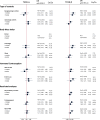Total Effective Xenoestrogen Burden in Serum Samples and Risk of Endometrial Cancer in the Spanish Screenwide Case-Control Study
- PMID: 38415615
- PMCID: PMC10901108
- DOI: 10.1289/EHP13202
Total Effective Xenoestrogen Burden in Serum Samples and Risk of Endometrial Cancer in the Spanish Screenwide Case-Control Study
Abstract
Background: Endometrial cancer is a hormone-dependent cancer, and estrogens play a relevant role in its etiology. However, little is known about the effects of environmental pollutants that act as xenoestrogens or that influence estrogenic activity through different pathways.
Objective: We aimed to assess the relationship between the combined estrogenic activity of mixtures of xenoestrogens present in serum samples and the risk of endometrial cancer in the Screenwide case-control study.
Methods: The total effective xenoestrogen burden (TEXB) attributable to organohalogenated compounds () and to endogenous hormones and more polar xenoestrogens () was assessed in serum from 156 patients with endometrial cancer (cases) and 150 controls by combining chemical extraction and separation by high-performance liquid chromatography with the E-SCREEN bioassay for estrogenicity.
Results: Median and levels for cases (0.30 and , respectively) and controls (0.42 and , respectively) did not significantly differ ( and 0.933, respectively). An inverted-U risk trend across serum and levels was observed in multivariate adjusted models: Positive associations were observed for the second category of exposure in comparison to the lowest category of exposure [ (95% CI: 1.13, 3.94) for , and (95% CI: 1.62, 6.81) for ], whereas no significant associations were observed between the third category of exposure and the first [ (95% CI: 0.64, 2.31) for , and (95% CI: 0.75, 3.33) for ]. In mutually adjusted models for and levels, the association of with endometrial cancer risk was attenuated [ (95% CI: 0.61, 3.47) for the second category of exposure], as well as estimates for (; 95% CI: 1.03, 6.99). Most of the individual halogenated contaminants showed no associations with both TEXB and endometrial cancer.
Conclusions: We evaluated serum total xenoestrogen burden in relation to endometrial cancer risk and found an inverted-U risk trend across increasing categories of exposure. The use of in vitro bioassays with human samples may lead to a paradigm shift in the way we understand the negative impact of chemical mixtures on human health effects. These results are relevant from a public health perspective and for decision-makers in charge of controlling the production and distribution of chemicals with xenoestrogenic activity. https://doi.org/10.1289/EHP13202.
Figures
![Figures 1A and 1B are line graphs, plotting odds ratio, ranging from 0 to 2.5 in increments of 0.5 (y-axis) across total effective xenoestrogen burden of alpha fraction [estradiol equivalent units picomolar per milliliter], ranging from 0 to 5 in unit increments (x-axis, Figure 1A) and odds ratio, ranging from 0 to 2 in increments of 0.5 (y-axis) across total effective xenoestrogen burden of beta fraction [estradiol equivalent units picomolar per milliliter], ranging from 0 to 10 in increments of 2 (x-axis, Figure 1B).](https://cdn.ncbi.nlm.nih.gov/pmc/blobs/9024/10901108/74bb010bdeb0/ehp13202_f1.gif)

Similar articles
-
Total Effective Xenoestrogen Burden in Serum Samples and Risk for Breast Cancer in a Population-Based Multicase-Control Study in Spain.Environ Health Perspect. 2016 Oct;124(10):1575-1582. doi: 10.1289/EHP157. Epub 2016 May 20. Environ Health Perspect. 2016. PMID: 27203080 Free PMC article.
-
Male specific association between xenoestrogen levels in placenta and birthweight.Environ Int. 2013 Jan;51:174-81. doi: 10.1016/j.envint.2012.10.004. Epub 2012 Dec 21. Environ Int. 2013. PMID: 23262415
-
Changes in the total effective xenoestrogen burden (TEXB) of breast cancer patients during an 18-month post-surgical follow-up.Reprod Toxicol. 2017 Apr;69:212-220. doi: 10.1016/j.reprotox.2017.03.007. Epub 2017 Mar 10. Reprod Toxicol. 2017. PMID: 28288811
-
[Xenoestrogen effects of chemical compounds: influence on the breast cancer].Med Arh. 2006;60(6 Suppl 2):97-100. Med Arh. 2006. PMID: 18172994 Review. Bosnian.
-
Endogenous estrogens and the risk of breast, endometrial, and ovarian cancers.Steroids. 2015 Jul;99(Pt A):8-10. doi: 10.1016/j.steroids.2014.12.013. Epub 2014 Dec 30. Steroids. 2015. PMID: 25555473 Review.
Cited by
-
Interference with Systemic Negative Feedback Regulation as a Potential Mechanism for Nonmonotonic Dose-Responses of Endocrine-Disrupting Chemicals.bioRxiv [Preprint]. 2024 Sep 8:2024.09.04.611257. doi: 10.1101/2024.09.04.611257. bioRxiv. 2024. Update in: Toxicol Sci. 2025 Aug 01;206(2):354-372. doi: 10.1093/toxsci/kfaf060. PMID: 39282254 Free PMC article. Updated. Preprint.
-
Invited Perspective: Closing the Loop of Nonmonotonicity-from Natural Hormones in Experimental Endocrinology to Endocrine Disruptors in Epidemiology.Environ Health Perspect. 2024 Feb;132(2):21304. doi: 10.1289/EHP14499. Epub 2024 Feb 28. Environ Health Perspect. 2024. PMID: 38415614 Free PMC article. No abstract available.
References
-
- Ferlay J, Ervik M, Lam F, Colombet M, Mery L, Piñeros M, et al. . 2018. Global Cancer Observatory: Cancer Today. http://gco.iarc.fr/today [accessed 18 February 2020].
MeSH terms
Substances
LinkOut - more resources
Full Text Sources

